January 1945 QST
 Table
of Contents Table
of Contents
Wax nostalgic about and learn from the history of early electronics. See articles
from
QST, published December 1915 - present (visit ARRL
for info). All copyrights hereby acknowledged.
|
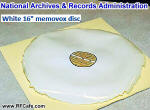
Memovox Disc :This disc recording format used 16"
(occasionally 12") discs of thin acetate and can be white, translucent or olive
green in color. Memovox discs have two hubs, one in the center and one off-set
to the side by about 1-½". The format was used for instantaneous recording in
the 1940s.
(National Archives photo)
We hear and read a lot in the news about the electronic surveillance
carried out by governments - on both foreign entities and civilians. If you
think this is a phenomenon that has only existed since the age of cellphones and
the Internet, you might be interested in this article that appeared in a 1945
issue of the ARRL's QST magazine. Long before the entire textual
content of the Encyclopedia Britannica could be carried on a USB stick in
your pocket - and access virtually all the information in the world on your
iPhone, engineers were developing recording media to facilitate the capturing
and later analysis of over-the-air and wired communications. They wanted both
encrypted and unencrypted conversations. The National Archives has a huge store
of magnetic tapes, vinyl discs, wax cylinders, and other media formats that the
interested individual can access and make an effort to document for posterity's
benefit. Most of it is useless and boring, but there have probably been a few
gems discovered that have gone heretofore unknown - probably nothing that would
have changed the course of history, but nonetheless noteworthy.
According to the
National
Archives:
Administrative History
Established: In the Federal Communications Commission (FCC), by FCC order, July
28, 1942.
Predecessor Agencies: Foreign Broadcast Monitoring Service, FCC (1941-42)
Transfers: To the Military Intelligence Division, War Department General Staff,
by order of the Secretary of War, December 30, 1945, pursuant to agreement between
FCC and War Department; to the Central Intelligence Group (CIG), National Intelligence
Authority, August 5, 1946.
Functions: Recorded, translated, and analyzed foreign broadcast programs.
Abolished: November 1, 1946.
Successor Agencies:
Foreign Broadcast Information Service, CIG, November-December,
1946. Foreign Broadcast Information Branch, CIG, January-September 1947. Foreign
Broadcast Information Service, Central Intelligence Agency, 1947- .
Finding Aids: Walter W. Weinstein, comp., Preliminary Inventory of the Records
of the Foreign Broadcast Intelligence Service, PI 115 (1959).
Security-Classified Records: This record group may include material that is security-classified.
Related Records: Records of the Foreign Broadcast Information Branch, 1947-48,
in RG 263, Records of the Central Intelligence Agency.
Hams in the FBIS
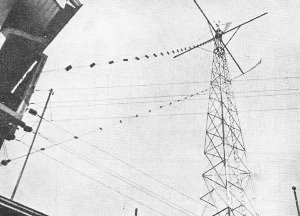
This maze of wire is but a small part of the elaborate system
required to receive faint radio signals emanating from all parts of the world. The
wires connect to twenty-nine communications-type receivers within the listening
station located near Silver Hill, Md.
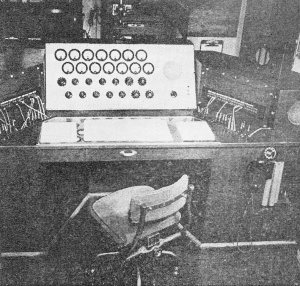
All programs received at Silver Hill are "piped" through this
monitoring console. The operator on duty adjusts the volume of each station to a
predetermined level suitable for recording purposes before it is sent on its way
to the interpreter who is situated many miles from the receiving station.
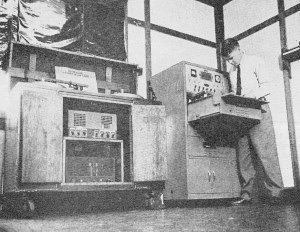
David Cooper, FBIS supervisor, records a broadcast on a Memovox
machine at the recording station. Over an hour's intelligence may be recorded on
each side of a flexible disc. Continuous recording is possible by using duplicate
machines. The console at the left is used for the recording of vital material where
the utmost in quality is required.
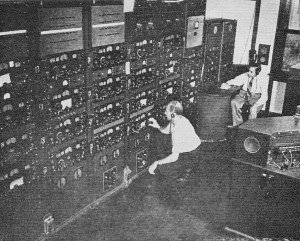
The monitoring officer in the foreground adjusts the receiver
of a station to be monitored a few minutes later. The officer in the background
scans the ether for new or unknown stations.
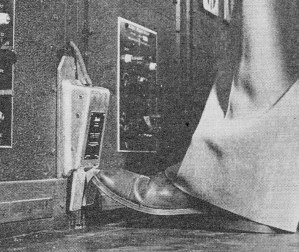
Instantaneous frequency checks may be made at any time by connecting
this special switch.
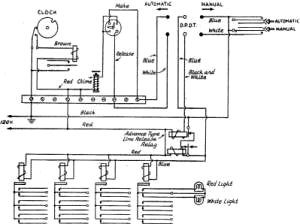
Fig. 1 - Diagram of the automatic timing device included in the
console control and used to cut programs in and out.
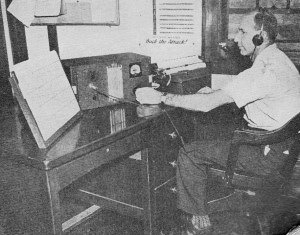
Each program received at the FBIS receiving station is recorded
on a special log which shows the exact time of reception and other pertinent information.
The operator selects various programs by rotating the switch.
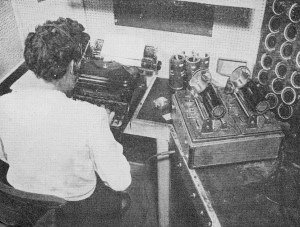
Mrs. Kay Kimmers, FBIS expert in Italian, French, Spanish and
German languages, transcribes a program from Europe. The same program is being recorded
simultaneously on wax cylinders for reference purposes and for checking copy.
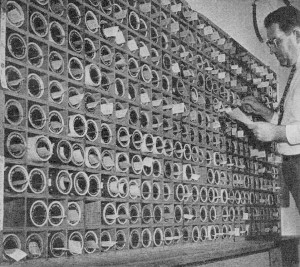
Victor Volmar, FBIS monitor, specializes in the German and Spanish
languages. Wax cylinders are kept for a period of forty-eight hours and contain
the original intelligence that has been received via the elaborate receiver installation
at Silver Hill, Md.
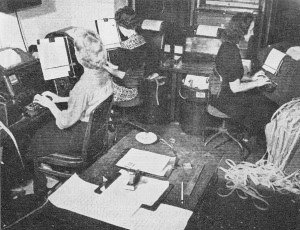
Incoming and, outgoing traffic passes through the teletype machines
which supply information to many government agencies both military and non-military.
These include the War. Navy and State Departments, OWI, Office of Censorship. and
a number of branches in Allied governments.
Left to right: Mrs. Elizabeth Holt, Mrs. Chris Kimbrough, and
Mrs. Helen Goss.
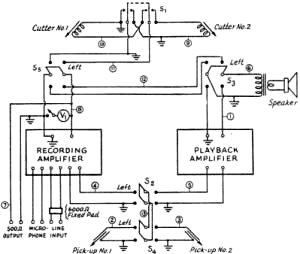
Fig. 2 - Wiring diagram of the acetate recorder in use at the
FBIS installation at Silver Hill. Md.
The Work of FCC's Foreign Broadcast Intelligence Service
By Oliver Read - W9ETI
The Foreign Broadcast Intelligence Service of the Federal Communications Commission
is responsible for a great portion of the news that finds its way to our daily newspapers
and is heard over our vast radio networks. You have often heard the following: "As
recorded by United States monitors," or, "As heard by United States Government monitors."
Who are these monitors and what do they do? As a matter of fact, they operate
one of the world's most elaborate systems of radio receivers. Their purpose is to
listen to, record, translate, summarize and report the broadcasts originating in
foreign countries. The FBIS is the sole governmental agency doing this job in the
United States. They do not transmit propaganda; that is done by the Office of War
Information.
It is interesting to note that the very develop-ment of the FBIS was born from
the realization that short-wave transmission was one of the most potent weapons of war. Our enemies have bombarded us with all sorts of propaganda
throughout this war. From it the FBIS is able to gather vital information which
is then used for counter propaganda.
In the early stages of the war, the French followed a not very successful policy
of attempting to jam German broadcasts reaching the vicinity of Paris. However,
the French Foreign Office deemed it so essential to keep informed of the contents
of those German outpourings that it established a listening post in Switzerland
to intercept the very broadcasts which its own jamming prevented it from hearing
inside France.
Today, every major nation in this global war and most of the neutral countries
operate a monitoring service as part of their essential government functions.
The maze of equipment required to handle the vast number of words recorded and
translated each day is tremendous. In fact, over 10,000 items (an average of 2,500,000
words) are received daily at FBIS listening posts at Silver Hill, Md.; Hayward,
Calif., and Portland, Ore. Manned largely by amateur personnel, these stations are
tuned in twenty-four hours a day to programs being transmitted from all the countries
of the world.
Silver Hill Installation
We visited the elaborate installation at Silver Hill, Md., recently in order
to witness firsthand the important functions of the FBIS.
There we found the chief monitoring officer to be Frank X. Green, who has long
been associated in the radio, public address and recording business. He entered
the service of the Commission at the outbreak of the war. There are four monitoring
officers: Conan W. Barger, formerly radio broadcast engineer of KFXJ, KFEL, KOA,
KMA and KIUL; Francis N. King, who was radio broadcast engineer at WKBW, WHBU and
WJTN, and formerly a short-wave radio operator on the Great Lakes; S. Vernon Ray,
former radio operator in the merchant marine, and Bernard P. Sloan, W2KT, former
chief radioman in the Navy and the Coast Guard and an operator in the merchant marine.
Assistant monitoring officers include: William A. Sodaro, former chief engineer
of a West Virginia network and radio operator from the Gulf of Mexico; Raymond B.
O'Neill, former telegraph operator with the New York Police Department; Hyman Wallin,
formerly a merchant marine radio operator; James G. Wedewer, an official of several
short-wave listening clubs and an outstanding authority on short-wave broadcast
stations of the world; George E. Hathaway, former radio operator in the merchant
marine, the Army, and for Western Union, and Russell G. Eversole, W3AXY, former
radio operator in the merchant marine.
This fellow James Wedewer mentioned above can give you the location of any listed
short-wave station or broadcast station throughout the world. We had quite a talk
with this lad and picked call letters out of "blue sky" to test his ability to recognize
the station. His quick identification was amazing. The receiving station at Silver
Hill is concerned only with broadcasts originating from European and African short-wave
stations. The other FBIS receiving stations are very similar to that situated at
Silver Hill, Md. The one at Portland, Ore., takes care of Japanese-language broadcasts
and the one at Hayward, Calif., records signals from the Far East and from the U.S.S.R.
Functions of the FBIS
There are nine successive steps in the operations of the FBIS: (1) scheduling;
(2) intercepting, (3) and (4) monitoring and recording (which go on simultaneously),
(5) translating, (6) wire service which includes editing and teletyping, (7) reports
which include editing and mimeographing, (8) analyses including periodic and special
reports, and (9) individual services of many kinds.
First comes the scheduling of all programs which are to be intercepted at each
listening post during each listening period. An accurate index which includes frequencies,
hours, languages, and program types is prepared. This comprehensive index lists
over 6000 programs and is kept currently accurate.
Step number two is performed by the engineers, each of whom is in charge of a
large number of Hallicrafters SX-28 communications-type receivers which are in continuous
service. The performance and calibration of each receiver is known at all times.
A gadget has been installed by the FBIS personnel so that a 100-kc. or a 1000-kc.
signal may be injected to any receiver for a frequency check by connecting a special
switch. The source of this signal is a crystal-controlled secondary frequency standard.
Having received his schedule, the operator tunes in in advance the requisite
number of receivers to the stations, making sure that. the signals are being received
at best audibility. At precisely the right moment, he throws a switch, or an automatic
control developed by the FBIS, cutting in the proper programs for recording and
monitoring. He then retunes unused receivers to be held in readiness for following
scheduled programs.
Other engineers patrol the ether continuously in search of new, changed, and
discontinued programs so that an accurate "log" is always available. All programs
are listed on a daily chart which gives a report on the audibility, signal strength,
etc., of each program.
The antenna system consists of five highly directional Rhombic antennas orientated
to cover a maximum of 20 degrees each. All of the Rhombics terminate to selector
switches so that any or all of the twenty-nine receivers may be instantaneously
connected into the feeder system. All inputs connect in parallel and series isolating
resistors to each receiver input permit an even distribution of received signals.
Like the RID, the personnel of the FBIS have installed their equipment in such
manner that greatest flexibility is realized. The receivers are installed in bays
as shown in the photographs. They are easily accessible from the rear to facilitate
servicing.
There is a small selector panel on each receiver bay which includes a voltmeter
to check the output of the receiver, a selector switch for the speaker and another
to select the proper Rhombic. Each receiver has its own calibration book placed
in a clip adjacent to the set. The hand-calibrated information is prepared for each
set in the installation. Operators can then determine by quick reference the exact
settings for a given frequency. Periodic checks are made, especially when sudden
changes in weather are encountered, to see that the calibration is accurate.
A control console which includes patch circuits and db. meters is an important part
of the installation. The output from each receiver terminates at the jacks on the
control console. From there signals are routed by wire to the recording and monitoring
office which is located many miles from the receiving station. The operator on duty
at the console "rides gain" on each channel in order that the signals arrive at
the downtown office at proper audio level for recording purposes. This allows the
translators to concentrate on the intelligence without being disturbed by having
to adjust individual volume controls to suit their particular needs.
Recording of Programs
Certain types of programs are recorded on paper-based discs on Memovox recorders
or, when high fidelity is required, on Presto acetate recorders. The latter equipment
is located at the receiving station.
Persons known as monitors sit before type-writers wearing headphones. This highly
trained personnel consists of experts familiar with many languages. Each monitor
specializes in one or more. He is thoroughly familiar with the phraseology and other
characteristics of the language he is monitoring. As he listens he translates the
material and makes a typewritten summary in the English language of the broadcast.
At the same time, dual wax-cylinder machines record the entire program so that the
monitor has a means of checking his copy and so that information can be held verbatim
for a period of forty-eight hours in case some governmental agency needs the complete
program for further observation and study. After the program's conclusion, the monitor
goes on to the next one shown on his schedule. Generally, he types only highlights
of the program, but if the item contains information of real importance in the judgment
of the supervising editor-monitor, the monitor turns from listening in to a succeeding
music period and translates the full text.
The next step in the operation is interposed between monitoring and editing for
a portion of recorded broadcasts. It is known as the translation of texts. One of
those in constant demand is the weekly Goebbels Das Reich article. This is sent
with the summary to the translation room as soon as recorded to be rendered into
English text. At present there are seventy-five expert translators in the FBIS having
ability to under-take thirty-four languages and thirty additional dialects.
Distribution of Material
The sixth, seventh and eighth steps in FBIS operations deal with the distribution
of material to various government agencies which use it. From the various listening
posts come summaries, texts and daily round-ups that flow into Washing-ton headquarters
minute by minute, day and night. They come by typed transcript, by teletype, by
cable, and by air mail and are then distributed to the element users.
The information goes out over six wires. The " A" wire terminates at the State
Department, War Department, Navy Department, OWI, Office of Censorship, British
Information Service, Canadian Wartime Information Board, the Philippine Mission
and Chinese Embassy. The "B" wire goes to OWI in New York and Washington. The "C"
wire, with Latin American material, goes to the office of the Coordinator of InterAmerican
Affairs. The "D" wire is a cable to the British Ministry of Information in England
and carries Japanese material monitored on the Pacific Coast. The "PW" wire goes
to the War Department, Office of the Provost Marshall General, and contains the
full text of all enemy-broadcast prisoners-of-war messages. The remaining "X" wire
connects to OWI in San Francisco and carries items relative to the Far East broadcasts
from Europe.
The seventh step in FBIS operations is the preparation and issuance of two mimeographed
daily reports.
The eighth step is the analysis of the volume of the recorded broadcast output,
the preparation of periodic reviews of broadcasts from and to particular areas and
the answer to the steady volume of queries regarding a particular subject, trend,
or transmitter.
Special Services
The ninth and final step deals with individual special services. Principal speeches
by German and Japanese leaders are recorded on the permanent high fidelity discs
previously mentioned and are furnished to the OWI and the British Overseas Broadcast
Agency for the Library of Direct Quotation. These recordings have been used to good
advantage in our own counter-propaganda. For example, six months after Tojo had
broadcast a boast about the impregnability of the Marshall Islands, there came bouncing
back to Japan his actual voice with its six-month-old boast accompanied by the damning
facts of the actual Marshall Island invasion. The Foreign Broadcast Intelligence
Service is one of the Government's most important non-military branches. We hams
may take pride in the fact that the FBIS has selected much of its personnel from
our ranks to operate this vital wartime agency.
Posted March 18, 2019(original 7/14/2011)
|








































